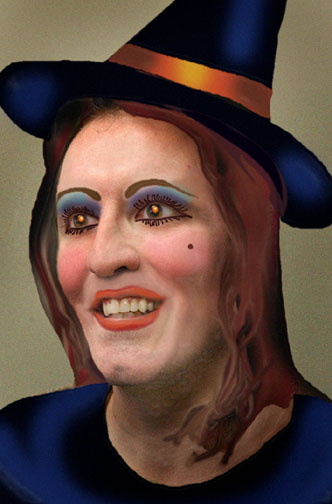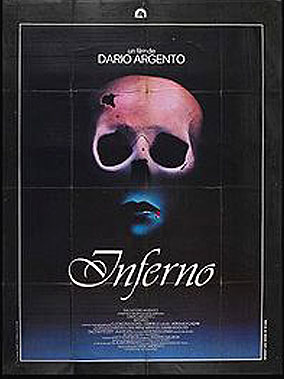mark mclaughlin
FOUR-LETTER WORD BEGINNING WITH `F'

Mark McLaughlin's fiction, nonfiction and poetry have appeared in more than 800 magazines, anthologies, newspapers, and websites, including Horror Garage, Doorways, Hungur, Cemetery Dance, Space & Time, The Black Gate, Galaxy, Writer's Digest, FilmFax, Dark Arts, Midnight Premieres, and two volumes each of The Best of the Rest, The Best of HorrorFind, and The Year's Best Horror Stories. Collections of his fiction include Pickman's Motel, Slime After Slime, Motivational Shrieker, At the Foothills of Frenzy (with Shane Ryan Staley and Brian Knight), and All Things Dark and Hideous (with Michael McCarty). Also, he is the co-author, with Rain Graves and David Niall Wilson, of the poetry collection The Gossamer Eye, which won a Bram Stoker Award for Superior Achievement in Poetry. His most recent poetry collection, Phantasmapedia, was a finalist for the Stoker Award.
In September 2008, Delirium Books/Corrosion Press released Monster Behind the Wheel, a novel Mark wrote with collaborator Michael McCarty. In that same month, Skull Vines Press released Attack of the Two-Headed Poetry Monster, also co-written with Michael McCarty.
These and other books can be ordered at www.horror-mall.com. Be sure to visit Mark online at www.myspace.com/monsterbook and
www.myspace.com/poetrymonsterbook.
MAMMA MIA! ARGENTO'S WITCHES,
LIKE SHAFT, ARE BAD MOTHERS
Welcome, once again, to our online cauldron of cinematic terrors. This time around, we'll be stirring up a big, bubbling batch of Wiccaphobia, which is the official term for fear of witches. I should add, Wiccaphobia is not to be confused with Wikipediphobia -- fear of online reference material -- or Waikikiphobia, fear of Hawaiian resorts.
Personally, I think the official term for a fear of witches should be changed to Samanthaphobia, in honor of Samantha Stevens, the domestic spellcaster played by Elizabeth Montgomery on the vintage sitcom, Bewitched. In fact, from this point on, I shall refer to "fear of witches" as... Samanthaphobia.

Why? Because I don't think "Wiccaphobia" is a fair term. I know a few actual Wiccans, and they are so pleasant and friendly, I would hate to think that anyone would fear them. They are, in fact, worlds nicer than many receptionists I've had to deal with over the years, and receptionists are PAID to be nice (though frankly, some don't even try to earn their nice-bucks).
Surely the most complete and comprehensive analysis of witches in cinematic history (and as you might recall, we only concern ourselves with cinematic matters in this neck of the cyber-woods) would have to be the Three Mothers trilogy of Italian director Dario Argento: Suspiria (1977), Inferno (1980), and The Mother of Tears (2007).
Thirty years passed between the release of the first and last segments of the Argento witch trilogy, but you really can't tell from watching them ... though I will admit, the hero's moussed, feathered hair-helmet and full mustache in Inferno do scream "Eighties!"
The concept of Argento's witch trilogy came from Suspiria De Profundis, the sequel to Confessions of an English Opium Eater by English writer Thomas De Quincey (1785-1859). Many horror viewers find the Argento trilogy confusing (albeit entertaining), but in fact, one needs to take a look at the source material that inspired these movies to understand them fully.
So please, take my hand. I'll lead the way.

In De Quincey's Suspiria De Profundis is a section entitled "Levana and Our Ladies of Sorrow," which informs us that just as there are three Graces, there are also three Sorrows: Mater Suspiriorum, Our Lady of Sighs; Mater Tenebrarum, Our Lady of Darkness; and Mater Lachrymarum, Our Lady of Tears. In Levana and Our Ladies of Sorrow, we are treated to these passages:
"The eldest of the three is named Mater Lachrymarum, Our Lady of Tears. She it is that night and day raves and moans, calling for vanished faces. ... Her eyes are sweet and subtle, wild and sleepy, by turns; oftentimes rising to the clouds, oftentimes challenging the heavens.
"The second sister is called Mater Suspiriorum -- Our Lady of Sighs. ... her eyes, if they were ever seen, would be neither sweet nor subtle; no man could read their story; they would be found filled with perishing dreams, and with wrecks of forgotten delirium.
"But the third sister, who is also the youngest--! Hush, whisper whilst we talk of her! ... (Her head) rises almost beyond the reach of sight. ... and her eyes rising so high might be hidden by distance; but, being what they are, they cannot be hidden; through the treble veil of crepe which she wears, the fierce light of a blazing misery, that rests not for matins or for vespers, for noon of day or noon of night, for ebbing or for flowing tide, may be read from the very ground. She is the defier of God. She is also the mother of lunacies, and the suggestress of suicides. ... her name is Mater Tenebrarum -- Our Lady of Darkness."
As you can see from these tantalizing excerpts, DeQuincey's three Mothers are surreal goddesses of strange beauty and boundless power. Argento's more down-to-earth interpretation of DeQuincey's vision recasts the Mothers not as otherworldly deities, but as supernaturally powerful, diabolically deceptive uber-witches.
It's interesting to note, in each of Argento's movies, the main witch fights a character with the first name of Sarah. In Suspiria, Sarah isn't the lead female character, but instead is a good friend of the heroine, Suzy (played by moon-eyed, hauntingly lovely Jessica Harper, who seems to sleepwalk through her entire performance). Sarah means "high holy one" in Hebrew, so either the characters named Sarah represent goodness, or maybe Argento really, really likes the name Sarah.
Also, throughout the trilogy, we learn that a scholarly architect and alchemist named Varelli build three houses for the witches: one in New York for Mater Tenebrarum, Mother of Darkness; one in Freiburg, Germany, for Mater Suspiriorum, Mother of Sighs; and one in Rome for Mater Lachrymarum, Mother of Tears. Varelli is a character in Inferno, though we don't discover that until the last quarter of the movie (Oh, by the way, I'll be giving away loads of plot information in the paragraphs to come, so if you don't like spoilers, you'd better stop reading now and watch all three movies before continuing. Go ahead. I'll still be here when you get back.).
In Suspiria, Mater Suspiriorum, Mother of Sighs, is a wealthy old witch named Helena Markos, the directress of a prestigious ballet academy, and the staff of the academy is her coven. Markos can make herself invisible and when she sleeps, she wheezes, moans, and gurgles. Mother of Sighs? More like Mother of Phlegm (they must not have witch-strength decongestants in Freiburg).















